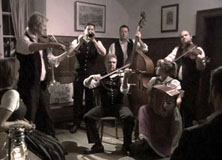 Play
Play

-
The second movement of Mahler’s First Symphony draws on the folk tradition of the Ländler, a heavy dance in 3/4 time. Here, its principal idea refers to the “Song of the Postilion.” In Mahler’s day, the post was delivered by horse-drawn coach, and the driver (or postilion) would play a horn or sing a song to announce his arrival.
 Play
Play
This movement incorporates a variety of quick mood changes. At times, Mahler asks the horn player to change the instrument’s sound by blocking the bell with the hand. Mahler uses this “stopped horn” effect to produce a spirited, and vulgar noise, appropriate to a drinking song.
